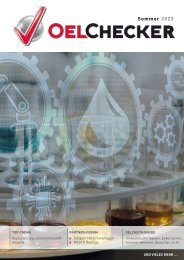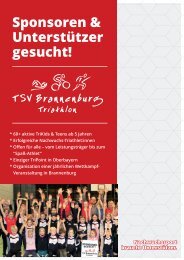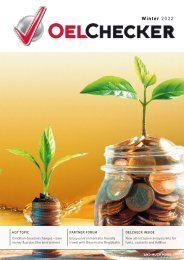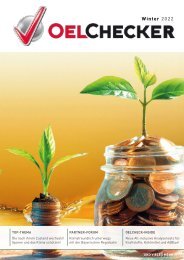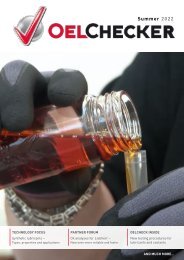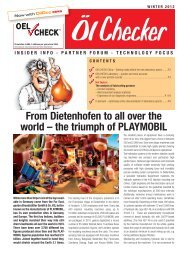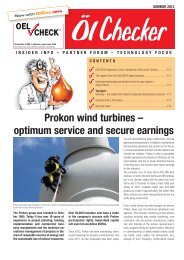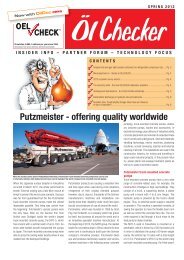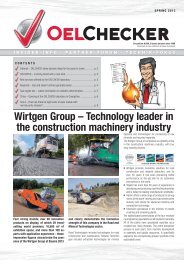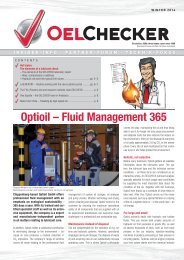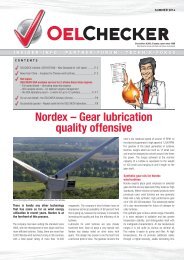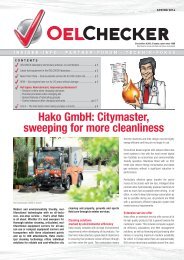OELCHECKER - Summer 2013
> Doppelmayr – Number 1 in the global cableway market > OELCHECK China – Even better service, made in Germany! > OELCHECK- Leakage test on our sample envelope > Bayernoil – Gas turbine generates power for a refinery > Hot Topics: Monitoring hydraulic fluids > Current trends > Requirements of DIN 51524 > OELCHECK analyses kits for hydraulic fluids > OELCHECK special investigations > Q & A – Seals leakages after oil change > OilDoc news
> Doppelmayr – Number 1 in the global cableway market
> OELCHECK China – Even better service, made in Germany!
> OELCHECK- Leakage test on our sample envelope
> Bayernoil – Gas turbine generates power for a refinery
> Hot Topics: Monitoring hydraulic fluids
> Current trends
> Requirements of DIN 51524
> OELCHECK analyses kits for hydraulic fluids
> OELCHECK special investigations
> Q & A – Seals leakages after oil change
> OilDoc news
- No tags were found...
Create successful ePaper yourself
Turn your PDF publications into a flip-book with our unique Google optimized e-Paper software.
SUMMER <strong>2013</strong><br />
Circulation: 9,500; 3 issues per year since 1998<br />
Download at www.oelcheck.de/news downloads<br />
CONTENTS<br />
OELCHECK China – Even better service, made in Germany! .................... pg 3<br />
OELCHECK- Leakage test on our sample delivery pouch ..........................pg. 3<br />
Bayernoil – Gas turbine generates power for a refinery ...........................pg. 4<br />
Hot topics:<br />
Monitoring hydraulic fluids<br />
– Current trends<br />
– Requirements of DIN 51524<br />
– OELCHECK Analyses kits for hydraulic fluids<br />
– OELCHECK Special investigations .................................................... pg. 5-7<br />
Ask Us – Seals leakages after oil change ................................................pg. 8<br />
Doppelmayr – Number 1 in<br />
the global cableway market<br />
Up, up and away with the CabriO open-top cableway! The fi rst cableway in the world which can<br />
accommodate 30 passengers on its upper deck fl oats up towards the Stanserhorn in Switzerland!<br />
On a par with elevators, cableways are at<br />
the top of the list worldwide in matter of<br />
safe transportation! A worldwide quality<br />
and technology leader in the cableway<br />
sector, the Doppelmayr/Garaventa Group<br />
is decisively involved in this.<br />
Doppelmayr began its story of success as an innovative<br />
mechanical engineering company in 1892.<br />
The company‘s first cableway was at the same time<br />
a highlight for one of the most famous ski areas of<br />
the world: The first Doppelmayr chairlift was built in<br />
1937, in Zürs am Arlberg. Since then, Doppelmayr<br />
has supplied more than 14,400 cableway systems<br />
to clients in more than 88 nations. The most recent<br />
milestones include the longest detachable gondola<br />
lift in the world - 5,801 m. It was put into operation<br />
at the beginning of April <strong>2013</strong>, in DaNang, Vietnam.<br />
The spectacular open-top CabriO cableway leads to<br />
the Stanserhorn in Switzerland. It is the first opentop<br />
cableway in the world. Of the up to 60 persons<br />
that can be accommodated in the cabin, 30 can<br />
enjoy the ride on the upper deck, with an unobstructed<br />
view of the alpine world. A system with<br />
integrated solar collector represents an important<br />
step in the direction of a sustainable future. The<br />
new photovoltaic chairlift, which generates a third<br />
of its own power consumption from solar energy, is<br />
operating in the Austrian ski resort of Golm.<br />
Headquartered in Wolfurt, in the Austrian federal<br />
state of Vorarlberg, the group of companies has<br />
production facilities, as well as sales and service<br />
locations, in more than 33 countries worldwide.<br />
These transport systems are setting new standards.<br />
Whether in summer and winter tourism areas, or in<br />
urban transport, people are moved with extremely<br />
comfortable and, most importantly, safe systems.<br />
Systems for the transport of materials and cableways<br />
for the preventive triggering of avalanches<br />
are convincing in their efficiency and performance.<br />
Multi-seasonal utilisation concepts complete the<br />
comprehensive range. However, wherever a new<br />
cableway system is installed, each one is carefully<br />
adapted according to its tasks and the environment.<br />
Cableways originated in high mountain areas.<br />
They withstand extreme temperature fluctuations,<br />
extreme winds and heavy snowfall, in other words:<br />
They have to perform under the most difficult conditions.<br />
Outside of the alpine environment, operating<br />
conditions are usually significantly milder, resulting<br />
in a high degree of operational safety and maximum<br />
availability.
Just like in the Wild West! Our summer festival at the<br />
beginning of August was literally hot, and the setting was truly<br />
perfect: A large Western saloon, the roadway of an old Gold<br />
Rush town, and all not very far from our Brannenburg lab. All the<br />
OELCHECK Indians, cowboys (and girls) and their families celebrated<br />
with enthusiasm! While panning for gold, a glittering nugget would<br />
turn up here or there, and shooting using the laser rifle required<br />
hawk‘s eyes and a steady hand. An exciting ride on the bull took<br />
some real commitment. „Chief“ Paul Weismann provided us with<br />
a demonstration of his strength and skill on the bull. But several<br />
cowgirls stayed on even longer than he did.<br />
We were completely charmed by the magician and his tricks. Peter Weismann assisted him in<br />
several astounding feats. The OELCHECK family kids of course also could not miss out on the<br />
Wild West festival. Everyone liked the pony rides, and the large paddling pool provided the<br />
right amount of cooling at 38°C. The evening arrived with a large barbecue, featuring Western-style<br />
delicacies. A country band started to play, and when the line dancers, after their great performance,<br />
asked everyone to join in, the dance floor filled up! Of course there were no real bullets at the<br />
OELCHECK summer festival – just a lot of fun and enjoyment while spending time together on an<br />
enchanting summer evening!<br />
Yours, Barbara Weismann<br />
The „Emirates Air Line“ in London<br />
Safety first – This is Doppelmayr‘s motto in<br />
regard to lubricating systems. In order to exclude<br />
right from the start all risks incurred through the<br />
possible use of inadequate lubricants, all new<br />
systems are filled at the factory, using only selected<br />
and internally approved products. Doppelmayr uses<br />
only special oils and greases that have been extensively<br />
tested and found to deliver optimum results<br />
during long-term operation under all possible environmental<br />
conditions. Lubricants are also delivered<br />
The „Mariche Tramo Expreso“ is located in Caracas/<br />
Venezuela<br />
in the original Doppelmayr containers. Clients will<br />
recognise the original product by its blue colouring.<br />
The operating instructions for each cableway<br />
include a list of lubricants that have been approved<br />
by Doppelmayr for filling or refilling. In case of using<br />
other products, Doppelmayr does not assume any<br />
liability in regard to functional safety, and warranty<br />
claims will be excluded. Oils used for the brake hydraulics<br />
and the cable hydraulic clamping systems<br />
are especially thoroughly inspected. The reliability<br />
of the hydraulic oils is of paramount importance<br />
in this. Brake hydraulics and the emergency drive<br />
hydrostat contain up to 200 l of hydraulic fluid.<br />
In the past, the system‘s cables were kept under<br />
tension using huge weights, nowadays, hydraulic<br />
cable tensioning systems that contain up to 450 l of<br />
hydraulic oil are used for this purpose. Depending<br />
on the system, the tension force can be between<br />
300 and 1,200kN. To prevent too much slip on the<br />
cables, a constant base tension is required. However,<br />
the cable cannot be overly tight either, since<br />
this could potentially cause damage to other system<br />
components.<br />
The approved long-term synthetic hydraulic oils are<br />
especially suited to utilisation across a wide range<br />
of temperatures. Selected ingredients improve<br />
the ageing properties and increase the corrosionprotection<br />
capacity. At the same time, the glide<br />
properties and wear protection of the hydraulic<br />
components are optimised. In extremely low and/<br />
or high temperatures, Doppelmayr uses a partially<br />
synthetic fluid with multigrade characteristics.<br />
Shear stable VI (viscosity index) improvers guarantee<br />
highly consistent viscosity even during extreme<br />
use, such as operation at below freezing temperatures.<br />
Condensation and possibly percolated water<br />
are precipitated very rapidly and completely, and<br />
can thus be drained in the course of a brief standstill<br />
without having to replace the entire fill.<br />
Doppelmayr provides a well connected customer<br />
service network around the world. Prior to each<br />
season, i.e. once or twice a year, a major inspection<br />
is performed on each cableway. If this is not possible<br />
during the day, the inspections are carried out<br />
at night, step by step. The operator can also choose<br />
to have their own customer service perform maintenance<br />
on the system. For monitoring the greases,<br />
gear- and hydraulic oils, as well as to check wear on<br />
the components which they lubricate, service technicians<br />
recommend the proven lubricant analyses<br />
of OELCHECK. The analyses kits are a fixed component<br />
in the range of spare parts. In the course<br />
of examining the gear- and hydraulic oils, among<br />
other things, contamination, e.g. by water or tramp<br />
oil, and purity classes are thoroughly checked.<br />
Water and an inadequate purity of fluids present the<br />
greatest threats to gears and hydraulics. Operators<br />
that receive a green symbol on their OELCHECK<br />
lab report are given the go-ahead by Doppelmayr<br />
to change the oils as needed, no longer on a fixed<br />
schedule, but depending on their condition. This<br />
reduces the cableway operators‘ cost for lubricants<br />
and maintenance.<br />
And Doppelmayr knows: With the OELCHECK lubricant<br />
analyses, everyone is on the safe side.<br />
2
OELCHECK INSIDER INFO<br />
It fulfils its promise –<br />
The OELCHECK sample delivery pouch<br />
Our employee‘s method of filling the OELCHECK<br />
delivery pouch is of course not recommended!<br />
However, after receiving<br />
several complaints about<br />
oil-stained mail, we put it to<br />
the test once again.<br />
We put it to the test and fi lled 200 ml of oil<br />
directly into the delivery pouch instead of<br />
a sample container.<br />
The result: The pre-addressed delivery pouch included<br />
with our analysis set is truly leak proof! It<br />
is made of oil-proof plastic<br />
material, and performs as<br />
promised.<br />
Provided, however, that the<br />
sender has properly sealed<br />
it using the self-adhesive<br />
closure.<br />
The plastic pouch was then properly closed.<br />
It completely seals and leak-proofs the delivery<br />
pouch, in case a sample container has not been<br />
correctly closed and fluid<br />
leaks out. To prevent oil<br />
stains, the sample information<br />
sheet travels piggyback,<br />
in a transparent plastic bag<br />
located on the outside.<br />
Then came the big test: Closed side down, oil loose<br />
on the inside. The result: The OELCHECK delivery<br />
pouch is leak proof!<br />
OELCHECK China – Even better service, made in Germany!<br />
At the OELCHECK lab in Guangzhou, in the South of China, things are really<br />
moving! Since the official opening in March of <strong>2013</strong>, many of our customers<br />
in China are now also benefiting from the advantages of our OELCHECK lubricant<br />
analyses. Our lab is almost identical to the one in Brannenburg, since the<br />
data acquired in China is transferred to the German system over a secure data<br />
link and interpreted there right away by the German engineers. This way, our<br />
customers in the Far East are not forced to do without the experience of the<br />
engineers in Germany. – However, apart from lubricant analyses, we offer a<br />
complete package of additional services in China.<br />
Our German experts are deployed in China on a regular basis, and are at your<br />
disposal for:<br />
• training your employees and customers<br />
• the selection and simplification of the types of lubricants used<br />
• the fixing of longer oil-change intervals<br />
• the assessment of cases of damage.<br />
Dipl.Ing. (FH) Steffen Bots (in the photo, on the left) is the OELCHECK<br />
diagnostic team manager, and will provide you with an individual consultation.<br />
Wherever you operate, we at OELCHECK are there for you!<br />
Good investment for young and old –<br />
The 2012 OELCHECK Christmas donation<br />
It‘s good to give! In fact, for several years now, we no longer give gifts to our customers at Christmas. Instead,<br />
we invest the corresponding sum into the most diverse projects in our home community of Brannenburg.<br />
In 2012, the amount of the donation was €15,000, and all local organisations involved in intensive social<br />
work for children or youths, or that are dedicated especially to the elderly, were given the chance to participate.<br />
Hugo Weismann and Nora Bots, our youngest at OELCHECK, acted as the lucky stars in our lottery<br />
of donation cheques, valued between €500 and €5,000. There was great joy at the unexpected windfall,<br />
and all the organisations found good use for the money. The societies for traditional costumes invested<br />
Lucky winners! A total of eight clubs were happy to win cheques in the 2012 OELCHECK Christmas donation<br />
lottery - all cheques have now been cashed!<br />
in clothing for their<br />
youngest members.<br />
In three kindergartens,<br />
the new, modern<br />
photo printers are very<br />
popular with the young<br />
artists. In the skate<br />
Have fun playing with<br />
park, €5,000 replaced<br />
the new equipment! The<br />
the dilapidated equipment<br />
Brannenburg Sports<br />
and installed new<br />
ramps. In the sports<br />
club, all three child and<br />
Club was also very happy<br />
about the OELCHECK<br />
Christmas donation for<br />
children and youths.<br />
youth departments were happy to receive a grant.<br />
And in the multigenerational house Flintsbach/<br />
Brannenburg, €5,000 went towards the purchase<br />
of a new vehicle to transport mobility challenged<br />
senior citizens.<br />
3
BAYERNOIL – Gas turbine<br />
generates power for a refinery<br />
The Transalpine oil pipeline (TAL) starts at<br />
the Triest oil terminal in north-eastern Italy,<br />
crosses the Alps to Schwechat, continues<br />
through Ingolstadt and ends at Karlsruhe,<br />
with a total length of 465 kilometres. It has<br />
transported over 1.2 billion tons of crude oil<br />
since it was put into service in 1967. That is<br />
an enormous volume, of which a large part is<br />
processed by Bayernoil refineries. Bayernoil<br />
is a refinery consortium of OMV Deutschland<br />
GmbH, Ruhr Oel GmbH, Eni Deutschland<br />
GmbH and BP Europa SE. The company<br />
operates the largest refinery in the Bavarian<br />
region and thus ensures the security of middle<br />
distillate supply in the region.<br />
From approximately 10.3 million tons of crude<br />
oil per year, Bayernoil produces quality products<br />
including liquefied gases, fuels, petrol, jet fuel,<br />
diesel, heating oil and bitumen. The capacity of the<br />
storage tanks is more than 1.8 million cubic metres.<br />
Around 725 employees work in the two company<br />
sites in Vohburg and Neustadt-on-Danube, some<br />
of them working in shifts to ensure that products<br />
will be available to company partners according to<br />
their requirements. The two operating sites work<br />
like a refinery at a single location. To make sure<br />
that this functions smoothly, they are connected by<br />
11 pipelines.<br />
„Refining means purifying or enhancing. Obtaining<br />
the full range of mineral oil products from crude oil<br />
requires a multi-stage process. It is split into its various<br />
components in different plants and further processed<br />
into fractions. The complex production processes<br />
run around the clock and are automatically<br />
controlled and monitored by trained employees in<br />
two control rooms. All finished products are subject<br />
to stringent internal and external quality control as<br />
specified by DIN and ISO standards, EC directives<br />
and the standards of the shareholders. The safety<br />
of the refinery takes first priority. In March <strong>2013</strong>,<br />
several plants in Vohburg were subjected to obligatory<br />
TÜV audits for the first time. A total of some<br />
4,500 different fittings and devices were checked<br />
or repaired. Overhauling and cleaning work took<br />
place in parallel. During the shutdown period, about<br />
1,500 additional employees from partner companies<br />
were working on the refinery sites.<br />
CHD heat exchangers – the product fed into the system is heated to initiate the chemical reaction<br />
with the catalyst.<br />
Onsite turbines supply power<br />
Operating the plants, in which every litre of crude<br />
oil has to be heated to over 200°C, requires an<br />
enormous amount of power. This is partly produced<br />
directly by Bayernoil. At the Neustadt location, part<br />
of the power supply is ensured by a large gas turbine.<br />
It has been operating for more than 20 years.<br />
Gas turbine being inspected for damage<br />
by a boroscope (endoscope).<br />
OELCHECK monitors turbine oils<br />
The gas turbine is lubricated by 6,500 litres of a<br />
semi-synthetic ISO VG 32 gas turbine oil. Every<br />
six years, it undergoes a major inspection. An<br />
oil change is needed about every three years. To<br />
allow this to be scheduled well in advance, the oil<br />
is tested every six months at OELCHECK in a trend<br />
analysis, since the gas turbine is the main source of<br />
power for the refinery. If it were damaged or failed<br />
unexpectedly, the resulting cost and effort would<br />
be considerable.<br />
Turbine oils, especially in gas turbines, must be<br />
monitored carefully. OELCHECK offers nine different<br />
analysis kits for testing turbine oil. Data for the<br />
turbine-specific parameters is provided on customised<br />
sample information sheets. Turbine oil sets<br />
also include larger sample containers (up to 1 litre),<br />
because certain test procedures, such as water<br />
and air separation characteristics, or foam release<br />
characteristics, require a fairly large amount of<br />
oil. For many years, the oil in the gas turbine at<br />
Neustadt has been tested twice a year using the<br />
OELCHECK T6 analysis kit. The remaining service<br />
life of the oil can be estimated from the trend data if<br />
the operating conditions do not change significantly.<br />
In addition to degradation of antioxidants in the oil,<br />
additional contaminants are detected at an early<br />
stage. This is important because all changes can<br />
adversely affect oil ageing, air release characteristics,<br />
wear protection and foaming characteristics.<br />
You can find an overview of all analysis sets,<br />
in particular for turbine oils, on:<br />
www.oelcheck.de/untersuchungsumfaenge.html<br />
4
OELCHECK TECHNOLOGY FOCUS<br />
Monitoring hydraulic fluids<br />
Whether in stationary systems such as injection moulding machines, presses and elevators, or in mobile systems such as construction<br />
and agricultural machines, loading plants or transport vehicles – hydraulic fluids are being used in the most diverse<br />
systems, and in almost all industries and companies. More than 125,000 t per annum are being sold in Germany alone. More<br />
than 10% of total mineral oil sales are accounted for by hydraulic oils. The fairly low-priced oil is still regarded by many as a<br />
simple supplies. But for a long time now, hydraulic oils have evolved into special fluids without modern hydraulic systems will<br />
often no longer function. However, the higher the levels of performance and specialisation, the more carefully these fluids must<br />
be maintained and monitored.<br />
Hydraulic fluids handle a wide range of tasks. They<br />
transfer forces, drive machines, assume control<br />
functions, lubricate moving parts, protect against<br />
wear and corrosion, cool, dampen vibrations, and<br />
remove possible contaminants. But the performance<br />
of modern hydraulic systems is increasing,<br />
and so are the demands made on the fluids.<br />
• More compact systems<br />
As a rule, the new systems are designed for<br />
smaller amounts of oil. However, a reduced volume<br />
of oil leads to shorter retention times in the<br />
oil container. Meaning that less time is available<br />
for cooling. The operating temperature of the<br />
fluid increases. In order to counteract the accelerated<br />
ageing process caused by the higher<br />
temperatures, hydraulic oils must be designed to<br />
be more oxidation proof.<br />
• Increasing pump pressures<br />
The heart of a hydraulic system is its pump,<br />
which produces an almost continuous volume<br />
flow. With high pressure, it transports the oil to<br />
its work sites, the hydraulic motors and hydraulic<br />
cylinders. In the past, depending on design, 400<br />
bar were reached on average. Nowadays, fluids<br />
must withstand pump pressures of 600 bar and<br />
more. Innovative hydraulic fluids are therefore<br />
designed with improved lubricity, thanks to<br />
which they can handle the higher mechanical<br />
stresses.<br />
• Decreased gap tolerances, perfected valve<br />
technology<br />
The increase in operating pressures is made<br />
possible not only by optimised pump technology,<br />
but also through decreased gap tolerances, better<br />
surface finishes and a more fine-tuned valve<br />
technology, letting components function even<br />
more efficiently and precisely. However, filterability<br />
and purity of the fluids must be regarded<br />
much more critically than in the past.<br />
• Higher Energy Efficiency<br />
Hydraulic systems should also operate on as<br />
little power as possible. The fuel for the diesel<br />
engines of the mobile hydraulic power units, or<br />
the power for the many stationary hydraulics are<br />
huge cost factors. Fluids that flow more easily at<br />
the same temperature, because they are either<br />
less thick or contain friction-reducing additives,<br />
allow for more cost-effective utilisation.<br />
• Permanent availability<br />
Hydraulic systems are expected to be permanently<br />
available, and in a state of maximum production<br />
safety. Modern systems fulfil these requirements,<br />
provided they use hydraulic oils that<br />
have been designed for long-term use. But even<br />
using these requires filtration and maintenance<br />
of the oil fill, as well as continuous monitoring of<br />
the oil by analysis.<br />
Hydraulic fluids and DIN 51524<br />
or ISO 11158<br />
There are numerous hydraulic oils, of different<br />
performance capacity, and for the most diverse applications.<br />
The classic and most used hydraulic oils<br />
of types HL (HL), HLP (HM), HLPD (HG), HVLP (HV)<br />
and HVLPD are mostly produced based on mineral<br />
oils. Rapidly biodegradable hydraulic oils according<br />
to DIN ISO 15380 are mostly synthetic oils based<br />
on saturated esters. Hydraulic systems with an elevated<br />
risk of fire, e.g. in foundries, hard coal mining<br />
industry, and aeronautics, require special fluids<br />
that are not easily ignited, and that do not continue<br />
to burn independently (more on this in the spring<br />
2011 edition of ÖlChecker). The most frequently<br />
sold hydraulic oils are specified in performance<br />
classes pursuant to DIN 51524 or ISO 11158.<br />
Abbreviated<br />
designation<br />
DIN 51524-x<br />
Abbreviated<br />
designation<br />
ISO 11158<br />
ISO 6743-4<br />
Performance class for hydraulic oils<br />
Brief description of the composition<br />
Remark<br />
H HH unalloyed mineral oils without additives mostly group I rarely used anymore<br />
HL HL as for H + corrosion protection<br />
+ oxidation inhibitors<br />
Mineral oil<br />
group II and III<br />
very rarely as hydraulic oil<br />
HLP HM as for HL + wear protection<br />
+ improved filterability;<br />
additives containing zinc and<br />
without zinc possible<br />
HVLP HV as for<br />
HLP<br />
+ high viscosity index for<br />
optimal V-T behaviour<br />
HLPD - as for HL + detergency and dispersing<br />
effect against water and dust<br />
HVLPD - as for<br />
HVLP<br />
- HG similar<br />
to HLPD<br />
+ with high VI for large<br />
temperature range<br />
+ dispersing capacity<br />
+ special friction coefficient<br />
characteristics<br />
Important minimum requirements of these oils are<br />
defined in DIN 51524 (parts 1 - 3) and ISO 11158.<br />
Besides purely physical data such as viscosity,<br />
density, flashpoint, pour point, ash or neutralisation<br />
number, typical tests relating to the area of operation<br />
are required.<br />
• Demulsification capacity: shows whether<br />
and how fast water separates from oil.<br />
• Air separation characteristics: makes it possible<br />
to draw conclusions in regard to cavitation<br />
tendency.<br />
• Foam behaviour: states whether the oil tends<br />
to form foam on its surface.<br />
• Seal compatibility: evaluates behaviour<br />
against elastomers.<br />
• Oxidation stability: provides information about<br />
long-term use.<br />
• Wear protection: is correlated using mechanical<br />
tests.<br />
• Purity classes: define a baseline cleanliness of<br />
the fresh oil.<br />
• Filterability: shows whether the oil composition<br />
may become a cause of filtration problems.<br />
However, the DIN specifications only represent the<br />
lowest common denominator for the fluid characteristics.<br />
One important aspect is not considered by the<br />
DIN at all: the miscibility of different hydraulic oils.<br />
mostly mineral<br />
oil, also groups<br />
II to V<br />
Groups III to V<br />
Groups II and III<br />
Groups III to V<br />
Groups II and III<br />
current standard,<br />
Problem: compatibility when<br />
using different additives<br />
energy-efficient fluids, large<br />
temperature operating range<br />
Use under wet and dusty<br />
conditions in mobile devices<br />
energy-efficient oils for large<br />
temperature range and in<br />
case of sludge formation<br />
when better antifriction<br />
properties are required<br />
5
OELCHECK TECHNOLOGY FOCUS<br />
There is no distinction between zinc-free or zinccontaining<br />
oils. HLP hydraulic oils can fulfil all requirements<br />
of DIN 51524-3, independent of whether<br />
additive combinations contain zinc to help achieve<br />
the performance level. The oils are miscible, but<br />
rarely compatible with each other in any ratio. This<br />
becomes especially apparent in a degradation of the<br />
air output characteristics, which provide information<br />
on the cavitation tendency of a fluid. Filterability and<br />
often also seal compatibility degrade when zinc-free<br />
and zinc-containing HLP oils are mixed.<br />
Synthetic fluids are the current trend<br />
High-grade hydraulic fluids with better base oils or<br />
synthetic base components are being utilised more<br />
and more frequently. In the past, the base consisted<br />
of simply refined mineral oils of API Group I,<br />
but nowadays, it is mostly the hydrated or hydrocracked<br />
oils (synthesised hydrocarbons) of groups II<br />
and III. Base oil group IV with its polyalphaolefines<br />
(PAO) offers an especially interesting outlook, as<br />
does group V with synthetic fluids such as esters,<br />
polyesters or glycols.<br />
The trend towards partially and fully<br />
synthetic fluids has a technical background:<br />
• Increased ageing stability<br />
In the manufacturing process of the synthetic<br />
oils, in oils of groups II and III molecular structures<br />
are saturated with hydrogen, while the sulphur<br />
content is reduced to less than 0.03%. In<br />
the oils of groups IV and V, molecules are newly<br />
formed. In either case, the viscosity temperature<br />
behaviour (higher VI) and ageing stability<br />
improve. All oils age depending on temperature<br />
and time in operation. In addition, ageing is accelerated<br />
by contaminants such as water, dust<br />
or wear particles. In contrast to mineral oils,<br />
hydrated (hydrogen saturated) oils, or pure synthetic<br />
oils, show fewer „weak points“, which can<br />
react with oxygen and initiate ageing, in their<br />
molecular structure. In addition, using modern<br />
anti-oxidants that are based on phenols, amines<br />
or salicylates (which neutralise „free radicals“),<br />
the oxidation tendency is suppressed until the<br />
additives are used up. For this reason, synthetic<br />
oils can remain in operation significantly longer<br />
than mineral oils.<br />
• Reduced formation of deposits<br />
Thanks to the advantages of synthetic fluids and<br />
sophisticated formulae, for the most part highgrade<br />
hydraulic fluids need fewer supplements<br />
and additives, which, as reaction products, can<br />
form deposits. Due to the naturally high VI, the<br />
viscosity-temperature behaviour does not have<br />
to be optimised with long-chain polymer compounds,<br />
which can cause sticky residue. Better<br />
lubrication properties help reduce the content of<br />
high pressure additives, the reaction products<br />
of which can form hard deposits. Filterability is<br />
improved and the function of precisely operating<br />
proportional valves is ensured. While they are<br />
in use, this also reduces the danger of deposits<br />
being formed in the system.<br />
• Expanded operating temperature,<br />
improved energy efficiency<br />
The efficiency of a hydraulic system can be<br />
significantly influenced by the viscosity of the<br />
fluid. The thinner a hydraulic oil, the lower the<br />
flow losses and the better the heat transfer. But<br />
a hydraulic oil that is too thin can cause internal<br />
losses, which has a negative effect on performance<br />
and leads to an increased oil temperature.<br />
Besides the pump speed and working pressure,<br />
hydraulic efficiency is highly dependent on the oil<br />
viscosity at the pump inlet. A high VI of the fluid<br />
not only achieves improved cold start behaviour,<br />
but also ensures that the viscosity remains as<br />
consistent as possible at different temperatures,<br />
thereby reducing flow- and churning losses.<br />
Besides ensuring optimum viscosity, a responsiveness<br />
of the friction-reducing additives that is<br />
adjusted to the working temperature improves<br />
energy efficiency.<br />
OELCHECK analysis kits for specialists<br />
and all-rounders<br />
Modern hydraulic oils save energy and can remain<br />
in operation longer. On the downside, they are<br />
considerably more expensive and usually react<br />
more sensitively. Regular monitoring of these oils<br />
will help to avoid unpleasant surprises. OELCHECK<br />
offers the standard analysis sets 2 - 5 for the<br />
analysis of hydraulic fluids. In addition, special sets<br />
are available for biodegradable or highly flammable<br />
fluids. All calculated values and visual findings will<br />
be commented on by experienced engineers, and<br />
recommendations will be made for further action<br />
in consideration of the system and the time in<br />
operation.<br />
Analysis kit 2: for mineral oil based<br />
hydraulic oils - up to app. 1,000 litres<br />
Our starter kit contains a range of tests that are<br />
usually sufficient for the routine monitoring of small<br />
to medium systems. The following parameters are<br />
monitored:<br />
• Wear metals: iron, chromium, tin,<br />
aluminium, nickel, copper, lead,<br />
manganese and molybdenum.<br />
• PQ index, which includes all magnetic<br />
wear particles, independent of their size.<br />
• Additive: calcium, magnesium, zinc, phosphorus,<br />
barium, boron, sulfur.<br />
• Contaminants: silicon (dust), potassium, sodium,<br />
lithium (grease), water.<br />
• Oil condition: Viscosity at 40°C and 100°C,<br />
viscosity index (reference to non shear-stable<br />
additives), oxidation by FT-IR, (also shows additive<br />
changes), visual impression (picture shows<br />
colouring or particles).<br />
• Particle count according to ISO 4406 provides<br />
information on the degree of contamination.<br />
Analysis kit 4: for synthetic hydraulic<br />
fluids - up to app. 1,000 litres<br />
Analysis set 4 includes all parameters of set 2 and<br />
also provides information on:<br />
• Water (using the Karl Fischer method):<br />
Each ppm of water counts, especially in<br />
the case of synthetic fluids in which water<br />
can lead to increased acid formation. Too much<br />
water can also cause corrosion, cavitation or oil<br />
oxidation. Depending on oil and system type,<br />
the water content of a hydraulic fluid should not<br />
exceed certain values (between 150 and 800<br />
ppm). In particular, low water contents cannot<br />
be determined precisely enough with the FT-IR<br />
method (set 2).<br />
• NZ or AN, the acid number: If this shows an<br />
increase in comparison to the clean oil values,<br />
it can be concluded that there is increased oil<br />
oxidation or the degrading of oil additives. It provides<br />
essential supplemental information for the<br />
extension of oil change intervals.<br />
Analysis kit 5: for all types of hydraulic oils -<br />
more than app. 1,000 litres<br />
Set 5 includes an additional analysis:<br />
• The RULER test: It is very important for large<br />
oil volumes or systems in which oil is not<br />
changed for years. This test determines<br />
ageing characteristics with particular precision,<br />
since the result given is the proportion of antioxidants<br />
still contained in the oil in relation to<br />
clean oil. Since oxidation inhibitors are continuously<br />
consumed while the oil is in operation, their<br />
residual amount and the operating time of the oil<br />
can indicate the remaining duration of use that is<br />
to be expected.<br />
Additional special tests<br />
The OELCHECK standard analysis sets cover all parameters<br />
relevant to statements regarding the further<br />
retention of a hydraulic fluid in the system. But<br />
sometimes a customer wants to delve deeper into<br />
the subject matter. In case of special questions and<br />
problems, our diagnostic engineers will be pleased<br />
to advise you. They will recommend individually selected,<br />
additional special tests. An entire palette of<br />
tests is available for your use.<br />
6
Brugger test KRL Filterability LAV<br />
Foam behaviour Demulsifi cation capacity<br />
TOST test<br />
Brugger test (DIN 51347)<br />
While DIN 51524 defines the minimum requirements<br />
for wear protection of the hydraulic fluids,<br />
their load capacity values can be subject to extreme<br />
fluctuations in practice. If, for example hydraulic<br />
cylinders stick-slip or rattle, and hydraulic pumps,<br />
especially vane pumps, show a decreased output,<br />
this indicates a fluid of inadequate performance.<br />
The Brugger test was developed to better evaluate<br />
the adhesion and wear protection of an oil on moving<br />
components. In the loaded pairing of a turning<br />
ring against a cylinder, over which oil is poured, an<br />
abrasion indentation is formed. The smaller this is,<br />
the better a hydraulic fluid is able to wet the paired<br />
surfaces, thereby suppressing squeaking noises<br />
and stick-slips.<br />
KRL, tapered roller bearing test (DIN 51350-6)<br />
Many hydraulic fluids, such as type HVLP, contain<br />
other VI improvers in addition to a good quality<br />
natural VI. These „thicken“ the oil, improve the<br />
viscosity temperature behaviour, and lend the fluid<br />
an above average multigrade characteristic. VI improvers<br />
consist of very long chain molecules, which<br />
can be severely sheared under load. At the same<br />
temperature, the used oil then becomes much<br />
thinner than the fresh oil. The loss of viscosity is<br />
irreversible. The effects on the hydraulic system of<br />
an oil that has become too thin at operating temperature<br />
are accordingly severe.<br />
One method to determine the change in viscosity<br />
as a result of the destruction of the VI improvers<br />
is the KRL test (tapered roller bearing). This variation<br />
of the four ball test (German: VKA) examines<br />
lubricants whose viscosity under high load should<br />
not change for a long time. The result provided by<br />
the KRL test is the viscosity before and after the<br />
test, as well as the relative decrease in viscosity<br />
at 100°C.<br />
Filterability (DIN ISO 13357-2)<br />
The filterability of an oil describes its behaviour<br />
while flowing through a filter. This test, which<br />
was originally developed for clean oils, provides<br />
the opportunity to check hydraulic oils that are<br />
still in development, to ensure that no prematurely<br />
blocked filters occur in practice. For used<br />
oils the test is used, for example, after an oil or<br />
filter change, filter service life has been shorten.<br />
Problems are often found as sticky deposits on the<br />
filter medium, or in the form of unsatisfactory oil<br />
purity. The cause of this can be another additivation,<br />
a different oil type, or the detachment of tribopolymers<br />
and the oil‘s own ageing products. In the case<br />
of reduced filter service life, testing the filterability<br />
of the used oil in comparison to that of the clean<br />
oil will quickly show whether the composition of<br />
base oil and additives is the cause of the problem,<br />
provided that all other technical values are equal.<br />
The filterability of an oil is given as a simple numerical<br />
value. If, for example, an HLP 46 clean oil<br />
achieves a value of F=98 in the filterability test, its<br />
filterability is excellent. If F values are lower than<br />
50, problems and decreased filter service life can<br />
be expected.<br />
LAV, Air separation characteristics<br />
(DIN ISO 9120)<br />
Just like water or other liquids, every oil contains<br />
air. Since it is „dissolved“ air, it cannot be seen in<br />
the form of bubbles. How much air a clean oil can<br />
absorb depends on its saturation behaviour. This<br />
is influenced mainly by the oil temperature, the oil<br />
type, the viscosity, the additivation, and the pressure<br />
in the system. The air absorption capacity also<br />
changes in the course of operation, by mixing oils<br />
that contain different additives, as well as through<br />
contaminants or oxidation products. Under the effects<br />
of temperature, the air dispersed throughout<br />
the oil may be released in the form of visible air<br />
bubbles. These are the cause for the „diesel effect“,<br />
or cavitation. A deterioration of the LAV in comparison<br />
with clean oil is often the reason for system<br />
malfunctions. The air output characteristic can be<br />
improved neither with additives nor by mechanical<br />
means.<br />
Because the exact air content in oil is difficult to<br />
determine, there is no standard for this. The LAV<br />
value determined in the OELCHECK lab indicates by<br />
means of density how long it takes until the air dispersed<br />
in oil is separated up to a residual content of<br />
0.2 volume percent.<br />
Foam behaviour (ASTM D892)<br />
Surface foam is formed when air bubbles with a<br />
diameter of more than 15 µm up to a few millimetres<br />
float up from the oil and do not immediately<br />
disintegrate. The walls of the gas-filled foam cells<br />
are formed by thin lamellae of liquid. Especially<br />
oils with a high content of additives tend to an increased<br />
foam formation. In contrast to the LAV test,<br />
the foam behaviour can be improved by foam inhibitors<br />
– mostly by those containing silicone. However,<br />
silicone oil may markedly deteriorate the air separation<br />
characteristic of oils. Therefore, caution should<br />
be exercised during a subsequent addition!<br />
The foam behaviour may deteriorate: When inhibitors<br />
are filtered out, oils age strongly, or oils with<br />
different surface tensions are mixed. An excessive<br />
foam formation may lead to an oil foam leak, and<br />
thus to environmental problems.<br />
In the lab, air-perfused high temperature insulating<br />
bricks (HTI bricks) in the oil are used to determine<br />
how long it takes until the surface foam disintegrates<br />
after stopping the air flow.<br />
WAV, demulsification capacity (DIN ISO 6614)<br />
Other than dust, hydraulic fluids are often contaminated<br />
by water, which may enter the system in<br />
the form of condensate but also during the highpressure<br />
cleaning process. Water accelerates the<br />
formation of corrosion. If it is heated in the points<br />
of contact due to friction, steam bubbles may<br />
form, which are the cause of cavitation in hydraulic<br />
pumps. A quick separation of the oil from the water<br />
is desirable. Hydraulic oils according to DIN 51524<br />
should have a demulsifying effect.<br />
However, the opposite effect can also be useful.<br />
For hydraulic oils of the non-standardised category<br />
HLP-D, the water is not to be separated, but to be<br />
neutralised by emulsification.<br />
The WAV test, in which oil and water are mixed in a<br />
ratio of 1:1 and then stirred, indicates after an idle<br />
period if, and how quickly, water separates from the<br />
oil. Frequently, the formation of an emulsion can<br />
also be observed through an intermediate layer, and<br />
this emulsion is responsible in practice for muddy<br />
deposits.<br />
TOST test (DIN EN ISO 4263)<br />
In large industrial facilities, hydraulic fluids must<br />
remain in use over several years. The oxidation<br />
stability plays an important role for the oils used in<br />
such facilities. For the assessment of used oils, the<br />
oil oxidation, or ageing, is determined with FT infrared<br />
spectroscopy and the change of NZ or of AN.<br />
A prediction, regarding which oil is better suited for<br />
long-term use, can be obtained with the TOST test.<br />
In the TOST test, pure oxygen flows through the<br />
warmed oil, to which water is added, for a period<br />
of about 3 months and in the presence of a copper<br />
coil. The increase of the acid reaction product<br />
formed during this process is regularly measured.<br />
The longer the process lasts, until the oil becomes<br />
“acid”, the more suitable it is for long-term use.<br />
Conclusion:<br />
Modern hydraulic fluids, which are partly or<br />
completely synthetic, in general offer a markedly<br />
higher performance than conventional hydraulic<br />
oils. They can remain in use longer, protect better<br />
against wear and cavitation, and help save energy.<br />
This also means, however, that their price is<br />
correspondingly higher. In order for an investment<br />
into these contemporary fluids to pay off and allow<br />
you to use their complete performance capability,<br />
you should monitor their use with our OELCHECK<br />
trend analyses.<br />
7
SUMMER <strong>2013</strong><br />
IMPRINT<br />
Due to the short oil service life, resulting<br />
from relatively high temperatures of<br />
over 75°C in the hydraulic tank, we<br />
changed the oil, around 6 weeks ago,<br />
in a few stationary hydraulic systems<br />
from a mineral oil-based hydraulic oil to<br />
a synthetic fluid. After the change, your<br />
lab reports show a residual content of<br />
mineral oil of less than 2%. With a value<br />
of 17/14/11, the oil purity was very good.<br />
There were no negative results. However,<br />
larger leakages have appeared on<br />
different seals more recently. What can<br />
be the reason for this?<br />
OELCHECK:<br />
In many applications, a seal is considered as a relatively<br />
unimportant and inexpensive machine element.<br />
Should it fail, however, this may have adverse effects<br />
not just for a hydraulic system. Engines or gears may<br />
loose so much oil due to failure of the seal that the<br />
result is inadequate lubrication, which may lead to<br />
damage, including the total failure of the system. In<br />
addition, for mobile applications, the environment<br />
may be greatly affected. If there is a substantial oil<br />
loss in connection with an oil change, the reason for<br />
this loss must be determined at all costs.<br />
In sealing techniques, the following principle applies:<br />
There are no leakage-free systems! This<br />
means, that there are always leakages. It is only a<br />
question of maintaining the system. For machines<br />
and plants, leakages may appear on static sealing<br />
locations, e.g. on screwed-on oil troughs, mounted<br />
valve blocks, or between half casings. However, oil<br />
drips are more frequent at sealing locations with<br />
dynamic stresses. Most problems occur on classic<br />
radial shaft seal rings (Simmerrings®) on rotating<br />
shafts or linear guideway seals, e.g. those installed<br />
in pistons with hydraulic movement.<br />
Q & A<br />
Lubricants interact strongly with sealants. On the<br />
other hand, they also contribute to the functioning<br />
of the sealing. Compatibility tests of standard<br />
sealing materials are thus required in the standards<br />
for gear oil, hydraulic oil and turbine oil. Some<br />
manufacturers even insist on their own approvals<br />
for seal materials. In general, any oil that meets<br />
the requirements is fine. Nevertheless, it happens<br />
again and again that, especially after an oil change,<br />
higher leakage amounts are detected even though<br />
the newly used oil showed good results during the<br />
tests with the sealants. There could be several<br />
reasons for that.<br />
• The viscosity, one of the most important oil<br />
characteristics, affects the mechanical sealing<br />
behaviour. If the new lubricant has a lower<br />
viscosity than the old one, it can leak more easily,<br />
e.g. in case of pre-damaged seals. If its viscosity<br />
is markedly higher, a thicker oil film is formed in<br />
case of linear movement. More oil can then be<br />
wiped off.<br />
• The compatibility between the oil itself and the<br />
sealant is normal, but problems appear when<br />
changing the oil. The compatibility between the<br />
oil and a relatively brand-new standard sealant is<br />
tested in the lab by a static storage in the upper<br />
temperature range. The compatibility between<br />
the oil and a relatively brand-new standard<br />
sealant is tested in the lab by a static storage<br />
in the upper temperature range. This means<br />
that the sealant should neither swell nor shrink,<br />
become neither harder nor softer, if it comes in<br />
contact with the lubricant. Both effects can be<br />
observed in practice. It depends on the base oil,<br />
the additives and the sealant to decide what<br />
direction to take.<br />
• When changing from mineral oil to synthetic<br />
oil, problems may definitely appear. Synthetic<br />
lubricants on the basis of polyalphaolefin or<br />
ÖlChecker – a magazine of OELCHECK GmbH<br />
Kerschelweg 28 · 83098 Brannenburg · Germany<br />
info@oelcheck.de · www.oelcheck.de<br />
All rights reserved. Reproduction without permission prohibited!<br />
Concept and text:<br />
Astrid Hackländer, Marketing & PR, 4600 Thalheim, Austria<br />
www.astridhacklaender.com<br />
Layout and design:<br />
Agentur Segel Setzen, Petra Bots, www.segel-setzen.com<br />
Photos:<br />
OELCHECK GmbH · Doppelmayr · Bayernoil · iStockphoto<br />
polyglycol often lead to a slight shrinking of<br />
standard seals. The contact pressure of sealing<br />
lips is slightly reduced, and the leakage amount<br />
increases. However, opposite effects are also<br />
possible. Thus, ester-based synthetic oils or<br />
modified or boosted additive systems may cause<br />
a softening, and thus a swelling of the seal. This<br />
is no less a problem because the seal, due to<br />
its “growing”, presses more strongly against<br />
a shaft for example, especially for dynamic<br />
sealing systems. The temperature at the sealing<br />
lip increases. Abrasion, ageing and brittleness<br />
result, which finally lead to the destruction of<br />
the seal.<br />
• When changing the oil, a markedly different acid<br />
number (neutralisation number/acid number) can<br />
result, for example from a different additive (with<br />
zinc or zinc-free, other type of oxidation inhibitor),<br />
which influences the interaction between oil<br />
and seal. The elasticity of a seal may change<br />
only slowly if the original oil was relatively “acid”<br />
(neutralisation number over 1.5 mgKOH/g)<br />
and the new oil reacts in a nearly neutral way<br />
(neutralisation number under 0.45 mgKOH/g).<br />
In principle, the following is true: as long as<br />
one meets the specifications and approvals of the<br />
system or the oil manufacturer, there are rarely<br />
any problems with seals. Leakages may appear if<br />
a different type of oil is used when changing the<br />
oil. Especially when using a different oil type, where<br />
the composition of the base oils and the formulation<br />
of additives differs, the effects with regard to the<br />
seals should be clarified.<br />
If you have questions about tribology or lubricant analysis, OELCHECK can answer them.<br />
Send us your questions by e-mail (info@oelcheck.de) or by fax (+49 8034-9047-47).<br />
8




